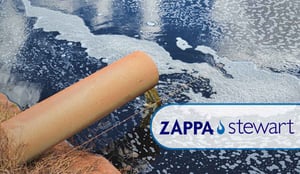 Liquid waste streams such as wastewater treatment sludge (biosolids), coal combustion residuals (coal ash slurries), horizontal direction drilling (HDD) mud, and dredged sediments are challenging to manage for many reasons. Regulatory restrictions on liquid waste disposal require free liquids to be absorbed, or solidified, prior to acceptance at landfill facilities. The absorbent material that is selected can impact the landfill’s leachate management costs, the landfill’s longevity, and the water quality in groundwater and surface water in the vicinity of the landfill. Superabsorbent polymers (SAPs), one of the EPA’s few accepted absorbent materials, help landfills minimize leachate management costs, mitigate environmental risks from leachate leaks, and maximize landfill life.
Liquid waste streams such as wastewater treatment sludge (biosolids), coal combustion residuals (coal ash slurries), horizontal direction drilling (HDD) mud, and dredged sediments are challenging to manage for many reasons. Regulatory restrictions on liquid waste disposal require free liquids to be absorbed, or solidified, prior to acceptance at landfill facilities. The absorbent material that is selected can impact the landfill’s leachate management costs, the landfill’s longevity, and the water quality in groundwater and surface water in the vicinity of the landfill. Superabsorbent polymers (SAPs), one of the EPA’s few accepted absorbent materials, help landfills minimize leachate management costs, mitigate environmental risks from leachate leaks, and maximize landfill life.
In most cases, liquid waste must pass the EPA’s Paint Filter Liquids Test (Method 9095B) prior to acceptance into a landfill. The paint filter test determines how much free liquid is present in a waste sample. However, the paint filter test provides only a snapshot of the state of the waste material prior to disposal and does not give an indication of what will happen once the waste is exposed to biodegradation and pressure inside a landfill.
 When biodegradable absorbent materials decompose or are subjected to pressure, the liquid that is trapped in the pore spaces and inner structure of the material is released. Release of sorbed liquids in a landfill results in increased landfill leachate, the liquid that percolates through landfill waste (mostly from precipitation). Landfill leachate is usually collected by a leachate management system and chemically treated for contaminants before being discharged. Increasing the liquid volume in a landfill causes an increase in the operation costs of a leachate management system, which can put an unexpected budgetary strain on municipal and private landfills. In addition to the increased operation costs, increased leachate volume can overwhelm the capacity of a leachate management system, often resulting in contaminated leachate seeps that can impact sensitive groundwater and surface water resources with harmful contaminants.
When biodegradable absorbent materials decompose or are subjected to pressure, the liquid that is trapped in the pore spaces and inner structure of the material is released. Release of sorbed liquids in a landfill results in increased landfill leachate, the liquid that percolates through landfill waste (mostly from precipitation). Landfill leachate is usually collected by a leachate management system and chemically treated for contaminants before being discharged. Increasing the liquid volume in a landfill causes an increase in the operation costs of a leachate management system, which can put an unexpected budgetary strain on municipal and private landfills. In addition to the increased operation costs, increased leachate volume can overwhelm the capacity of a leachate management system, often resulting in contaminated leachate seeps that can impact sensitive groundwater and surface water resources with harmful contaminants.
Examples of absorbent materials that release liquid under pressure and during decomposition are sawdust, auto fluff, and ground corncobs -- organic commodity materials that will decompose rapidly once exposed to the cocktail of microorganisms found in a landfill.
Related Article: 5 Reasons to Solidify Waste with Superabsorbent Polymers
Superabsorbent polymers offer the unique benefit of liquid retention, even under moderate pressures, such as the pressures that are observed in landfills (up to about 50 psi). Furthermore, SAPs are resistant to biodegradation, meaning that the liquid contained within the SAP matrix and pore spaces will be retained for multiple decades after being placed in a landfill. The SAP material and the liquid will eventually become incorporated into the humic fraction of the landfill waste.
Another feature of SAPs is the extremely high absorbency (300-400 lbs. of liquid per pound of SAP), which allows waste management contractors to maximize the waste liquid absorbed while minimizing the amount of absorbent material used. For comparison, to absorb the same amount of liquid with sawdust would likely require 100-200 times as much sawdust. Minimizing material placed in landfills also minimizes the volume of landfill airspace that is used, which ultimately prolongs the life of the landfill. New landfills are extremely costly and require many years of design, permitting, construction, and community buy-in so it is crucial to maximize landfill life. Imagine the air space that could be saved in landfills all over the world if more waste treatment professionals used high-absorbency SAPs rather than sawdust and other low-absorbency materials to solidify liquid waste.
For more information on superabsorbent polymer technologies and how SAPs are the right choice for landfills, please contact us.





